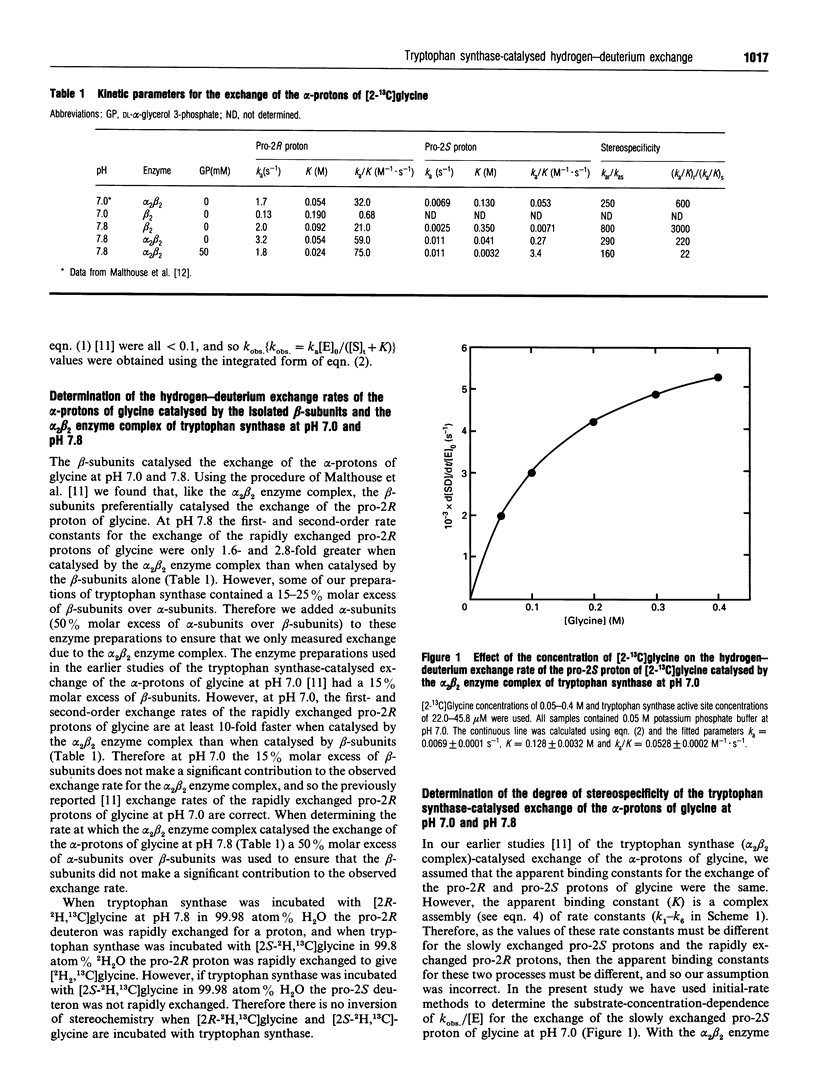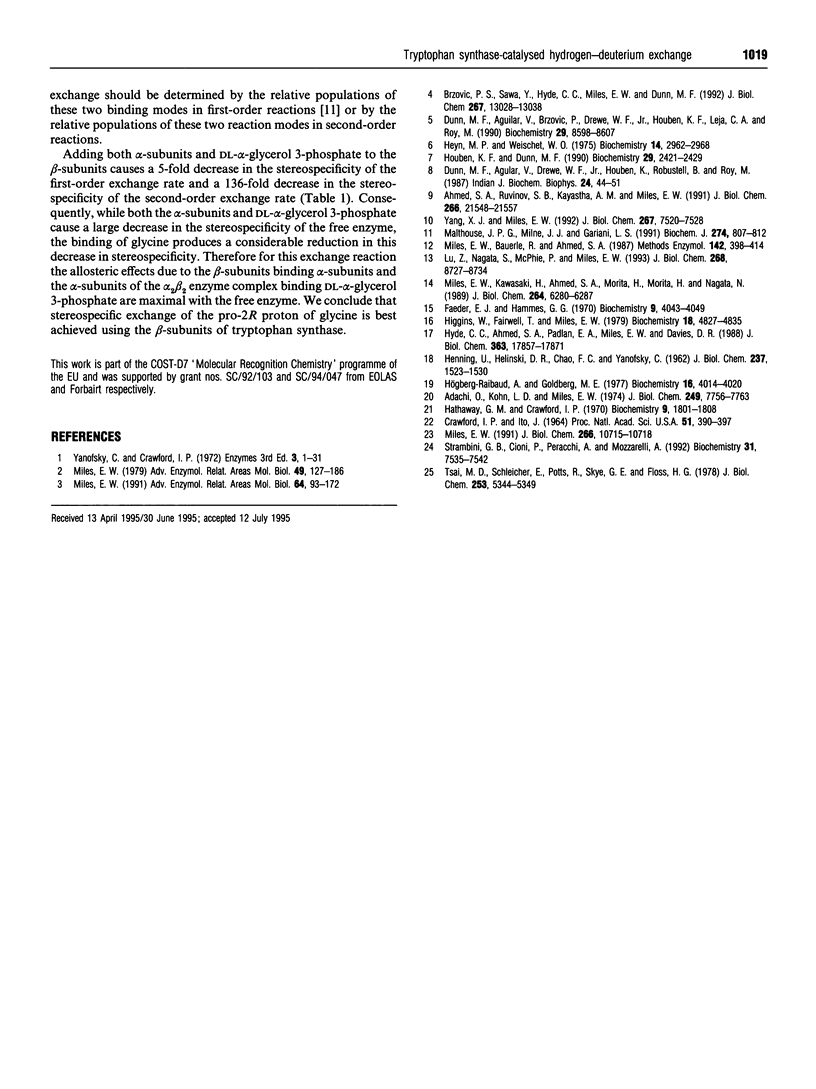Abstract
13C-NMR has been used to follow the tryptophan synthase (EC 4.2.1.20)-catalysed hydrogen-deuterium exchange of the pro-2R and pro-2S protons of [2-13C]glycine. The first- and second-order rate constants for exchange when the alpha 2 beta 2 enzyme complex is or is not saturated with glycine have been determined at pH 7.0 and 7.8. At pH 7.8 the effects of binding the allosteric effector, DL-alpha-glycerol 3-phosphate, and of removing the alpha-subunits have been examined. The beta-subunits preferentially catalyse the exchange of the pro-2R proton of glycine, but adding alpha-subunits decreases the stereospecificity of the exchange reactions. Likewise, binding of DL-alpha-glycerol 3-phosphate to the alpha 2 beta 2 enzyme complex causes a further decrease in the stereospecificity of this reaction. The stereospecificity of the second-order exchange reaction catalysed by the beta-subunits is 136-fold larger than that of the alpha 2 beta 2 enzyme complex in the presence of DL-alpha-glycerol 3-phosphate, while there is only a 5-fold decrease in the stereospecificity of the first-order exchange reaction under the same conditions. We discuss how these results relate to current theories which attempt to explain how the alpha-subunits and DL-alpha-glycerol 3-phosphate modify the catalytic properties of tryptophan synthase.
Full text
PDF




Selected References
These references are in PubMed. This may not be the complete list of references from this article.
- Adachi O., Kohn L. D., Miles E. W. Crystalline alpha2 beta2 complexes of tryptophan synthetase of Escherichia coli. A comparison between the native complex and the reconstituted complex. J Biol Chem. 1974 Dec 25;249(24):7756–7763. [PubMed] [Google Scholar]
- Ahmed S. A., Ruvinov S. B., Kayastha A. M., Miles E. W. Mechanism of mutual activation of the tryptophan synthase alpha and beta subunits. Analysis of the reaction specificity and substrate-induced inactivation of active site and tunnel mutants of the beta subunit. J Biol Chem. 1991 Nov 15;266(32):21548–21557. [PubMed] [Google Scholar]
- Brzović P. S., Sawa Y., Hyde C. C., Miles E. W., Dunn M. F. Evidence that mutations in a loop region of the alpha-subunit inhibit the transition from an open to a closed conformation in the tryptophan synthase bienzyme complex. J Biol Chem. 1992 Jun 25;267(18):13028–13038. [PubMed] [Google Scholar]
- CRAWFORD I. P., ITO J. SERINE DEAMINATION BY THE B PROTEIN OF ESCHERICHIA COLI TRYPTOPHAN SYNTHETASE. Proc Natl Acad Sci U S A. 1964 Mar;51:390–397. doi: 10.1073/pnas.51.3.390. [DOI] [PMC free article] [PubMed] [Google Scholar]
- Dunn M. F., Aguilar V., Brzović P., Drewe W. F., Jr, Houben K. F., Leja C. A., Roy M. The tryptophan synthase bienzyme complex transfers indole between the alpha- and beta-sites via a 25-30 A long tunnel. Biochemistry. 1990 Sep 18;29(37):8598–8607. doi: 10.1021/bi00489a015. [DOI] [PubMed] [Google Scholar]
- Dunn M. F., Agular V., Drewe W. F., Jr, Houben K., Robustell B., Roy M. The interconversion of E. coli tryptophan synthase intermediates is modulated by allosteric interactions. Indian J Biochem Biophys. 1987 Oct;24(5):suppl–51. [PubMed] [Google Scholar]
- Faeder E. J., Hammes G. G. Kinetic studies of tryptophan synthetase. Interaction of substrates with the B subunit. Biochemistry. 1970 Oct 13;9(21):4043–4049. doi: 10.1021/bi00823a003. [DOI] [PubMed] [Google Scholar]
- HENNING U., HELINSKI D. R., CHAO F. C., YANOFSKY C. The A protein of the tryptophan synthetase of Escherichia coli. Purification, crystallization, and composition studies. J Biol Chem. 1962 May;237:1523–1530. [PubMed] [Google Scholar]
- Hathaway G. M., Crawford I. P. Studies on the association of beta-chain monomers of Escherichia coli tryptophan synthetase. Biochemistry. 1970 Apr 14;9(8):1801–1808. doi: 10.1021/bi00810a020. [DOI] [PubMed] [Google Scholar]
- Heyn M. P., Weischet W. O. Circular dichroism and fluorescence studies on the binding of ligands to the alpha subunit of tryptophan synthase. Biochemistry. 1975 Jul;14(13):2962–2968. doi: 10.1021/bi00684a026. [DOI] [PubMed] [Google Scholar]
- Higgins W., Fairwell T., Miles E. W. An active proteolytic derivative of the alpha subunit of tryptophan synthase. Identification of the site of cleavage and characterization of the fragments. Biochemistry. 1979 Oct 30;18(22):4827–4835. doi: 10.1021/bi00589a010. [DOI] [PubMed] [Google Scholar]
- Houben K. F., Dunn M. F. Allosteric effects acting over a distance of 20-25 A in the Escherichia coli tryptophan synthase bienzyme complex increase ligand affinity and cause redistribution of covalent intermediates. Biochemistry. 1990 Mar 6;29(9):2421–2429. doi: 10.1021/bi00461a028. [DOI] [PubMed] [Google Scholar]
- Hyde C. C., Ahmed S. A., Padlan E. A., Miles E. W., Davies D. R. Three-dimensional structure of the tryptophan synthase alpha 2 beta 2 multienzyme complex from Salmonella typhimurium. J Biol Chem. 1988 Nov 25;263(33):17857–17871. [PubMed] [Google Scholar]
- Högberg-Raibaud A., Goldberg M. E. Isolation and characterization of independently folding regions of the beta chain of Escherichia coli tryptophan synthetase. Biochemistry. 1977 Sep 6;16(18):4014–4020. doi: 10.1021/bi00637a012. [DOI] [PubMed] [Google Scholar]
- Lu Z., Nagata S., McPhie P., Miles E. W. Lysine 87 in the beta subunit of tryptophan synthase that forms an internal aldimine with pyridoxal phosphate serves critical roles in transimination, catalysis, and product release. J Biol Chem. 1993 Apr 25;268(12):8727–8734. [PubMed] [Google Scholar]
- Malthouse J. P., Milne J. J., Gariani L. S. A comparative study of the kinetics and stereochemistry of the serine hydroxymethyltransferase- and tryptophan synthase-catalysed exchange of the pro-2R and pro-2S protons of glycine. Biochem J. 1991 Mar 15;274(Pt 3):807–812. doi: 10.1042/bj2740807. [DOI] [PMC free article] [PubMed] [Google Scholar]
- Miles E. W., Bauerle R., Ahmed S. A. Tryptophan synthase from Escherichia coli and Salmonella typhimurium. Methods Enzymol. 1987;142:398–414. doi: 10.1016/s0076-6879(87)42051-x. [DOI] [PubMed] [Google Scholar]
- Miles E. W., Kawasaki H., Ahmed S. A., Morita H., Morita H., Nagata S. The beta subunit of tryptophan synthase. Clarification of the roles of histidine 86, lysine 87, arginine 148, cysteine 170, and cysteine 230. J Biol Chem. 1989 Apr 15;264(11):6280–6287. [PubMed] [Google Scholar]
- Miles E. W. Structural basis for catalysis by tryptophan synthase. Adv Enzymol Relat Areas Mol Biol. 1991;64:93–172. doi: 10.1002/9780470123102.ch3. [DOI] [PubMed] [Google Scholar]
- Miles E. W. The tryptophan synthase alpha 2 beta 2 complex. Cleavage of a flexible loop in the alpha subunit alters allosteric properties. J Biol Chem. 1991 Jun 15;266(17):10715–10718. [PubMed] [Google Scholar]
- Miles E. W. Tryptophan synthase: structure, function, and subunit interaction. Adv Enzymol Relat Areas Mol Biol. 1979;49:127–186. doi: 10.1002/9780470122945.ch4. [DOI] [PubMed] [Google Scholar]
- Strambini G. B., Cioni P., Peracchi A., Mozzarelli A. Conformational changes and subunit communication in tryptophan synthase: effect of substrates and substrate analogs. Biochemistry. 1992 Aug 25;31(33):7535–7542. doi: 10.1021/bi00148a014. [DOI] [PubMed] [Google Scholar]
- Tsai M. D., Schleicher E., Potts R., Skye G. E., Floss H. G. Stereochemistry and mechanism of reactions catalyzed by tryptophan synthetase and its beta2 subunit. J Biol Chem. 1978 Aug 10;253(15):5344–5349. [PubMed] [Google Scholar]
- Yang X. J., Miles E. W. Threonine 183 and adjacent flexible loop residues in the tryptophan synthase alpha subunit have critical roles in modulating the enzymatic activities of the beta subunit in the alpha 2 beta 2 complex. J Biol Chem. 1992 Apr 15;267(11):7520–7528. [PubMed] [Google Scholar]


